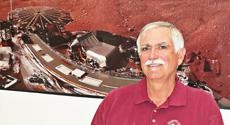While patiently awaiting any kind of communication from the red planet, the UA Mars exploration team is collecting and sorting data that the Phoenix Mars Lander retrieved on its mission that ended in mid-November.
The lander touched down on Mars on May 25, 2008 and operated for 150 days before it shut down due to a lack of available solar power. The next step for the team is to hope they can establish some form of contact with the lander, after the Martian winter subsides.
“”When it gets enough energy on its solar panels, it goes into a pre-programmed loop and starts trying to communicate,”” said Peter H. Smith of UA’s Lunar and Planetary Laboratory, principal investigator for the mission. “”All you have to do is listen.””
This amount of solar energy won’t be available until October, which is the Martian spring, he said.
“”The winters where it is are extremely cold,”” he said. “”Worse than Wisconsin. The temperatures are near -200 degrees.””
Until any communication can be recovered, the scientists involved in the mission are collecting and archiving the data, for other scientists to use in the future.
“”Right now we have all the data we expect to get,”” Smith said. “”There are some subtle signatures that take some time to figure out just what the heck you measured.””
Smith said one of the biggest discoveries so far is the possibility that there may be organic material in the soil.
“”The search for organics goes back to the Viking Landers in 1976,”” he said. “”They said there are no organics in the soil, so if we were able to prove that there were … that would be a huge discovery.””
Because of these discoveries, and the management of the program, the Phoenix Mars Lander team was awarded the 2009 John L. “”Jack”” Swigert Jr. Award for Space Exploration by The Space Foundation.
This award honors the memory of Jack Swigert, the command module pilot of the 1970 Apollo 13 mission.
“”It’s a high honor, it means a lot to be up in that pantheon of heroes,”” Smith said.
“”I feel extremely proud about that,”” said Stephanie Barnes, a 2008 Optical Sciences graduate who controlled the camera on Mars. “”Especially for the university as well because this is the first time a university has controlled something like this and to have that kind of recognition is pretty amazing.””
Around 40 or 50 other UA students worked alongside Barnes to assist the mission, Smith said.
“”A lot of students were able to work on this mission and it gave a lot of people basically a starting point in their career,”” Barnes said. “”The university was able to really put us students in key positions and we wouldn’t have had this kind of chance anywhere else.””
Barnes said she started out as an undergraduate intern and graduated one week before Phoenix landed on Mars.
“”I was all of the sudden thrown into this role of actually controlling this camera on Mars,”” she said. “”It was just the experience of a lifetime to go from a student to an engineer in a week and actually use everything I learned in school.””
As far as continuing with Mars exploration, Smith said “”were just getting our toes wet.”” The next missions are scheduled to launch in 2011 and 2013.
For right now, Smith still has hope for the Phoenix Mars Lander.
“”Maybe we’ll find our spacecraft again,”” he said. “”I’d like to say it’s in sleeping beauty mode.””









